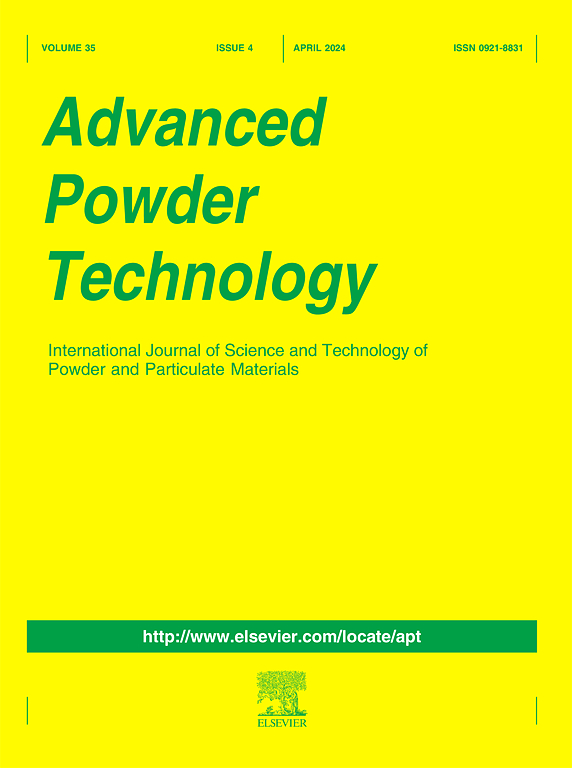Clean and efficient recovery of aluminum from aluminum-silicon alloy scrap by electrorefining using AlCl3-urea deep eutectic solvent
IF 4.2
2区 工程技术
Q2 ENGINEERING, CHEMICAL
引用次数: 0
Abstract
The upcycling of aluminum–silicon alloy scrap by electrorefining in AlCl3-urea DES at near room temperature was studied. The electrochemical behavior of impurity metals and aluminum was analyzed using the measurement of polarization curves. The result showed that the anodic dissolution of Al, Mn, Zn, Pb, Cu, Fe, Ni, and Si occurred at 0, 0.03, 0.21, 0.27, 0.60, 0.65, 0.87, and 1.65 V (vs. Al(Ⅲ)/Al) in AlCl3-urea DES, indicating that the anodic dissolution potential of metals in aluminum–silicon alloy in AlCl3-urea DES was in the order of Al > Mn > Zn > Pb > Cu > Fe > Ni > Si, different from the traditional metal activity series. This result also implied that aluminum was selectively dissolved from the aluminum–silicon alloy anode, whereas the impurity metals remained in the anode by controlling electrolytic potential. The influence of electrolytic parameters, such as electrolysis temperature and current density, on the electrorefining process and effect were studied. The purity of aluminum deposits was more than or equal to 99.5 %, and their microstructure ranged from particles to flower-like microspheres. The cathode current efficiency was approximately 87.8 % and the energy consumption was approximately 2.14 kW·h·kg−1-Al under the optimum conditions of electrolysis temperature 333 K and the current density 5 mA·cm−2. The process is energy efficient and produces aluminum with the purity comparable to that of primary aluminum. A real sustainability in the aluminum cycle is achieved through the application of this efficient and clean process.

用alcl3 -尿素深共晶溶剂电精炼法从铝硅合金废料中清洁高效地回收铝
研究了铝硅合金废料在alcl3 -尿素DES中近室温电精炼的升级回收。利用极化曲线测量分析了杂质金属和铝的电化学行为。结果表明:Al、Mn、Zn、Pb、Cu、Fe、Ni和Si在0、0.03、0.21、0.27、0.60、0.65、0.87和1.65 V (vs. Al(Ⅲ)/Al)条件下在AlCl3-urea DES中发生阳极溶解,表明AlCl3-urea DES中铝硅合金中金属的阳极溶解电位为Al >;Mn祝辞锌比;Pb祝辞铜比;菲比;倪祝辞Si,不同于传统的金属活性系列。这也说明铝硅合金阳极中铝被选择性地溶解,而杂质金属通过控制电解电位而留在阳极中。研究了电解温度、电流密度等电解参数对电精炼过程和效果的影响。铝镀层的纯度大于等于99.5%,其微观结构从颗粒到花状微球不等。在电解温度为333 K、电流密度为5 mA·cm−2的最佳条件下,阴极电流效率约为87.8%,能耗约为2.14 kW·h·kg - 1-Al。该工艺节能,生产的铝纯度与原铝相当。通过应用这种高效和清洁的工艺,实现了铝循环的真正可持续性。
本文章由计算机程序翻译,如有差异,请以英文原文为准。
求助全文
约1分钟内获得全文
求助全文
来源期刊

Advanced Powder Technology
工程技术-工程:化工
CiteScore
9.50
自引率
7.70%
发文量
424
审稿时长
55 days
期刊介绍:
The aim of Advanced Powder Technology is to meet the demand for an international journal that integrates all aspects of science and technology research on powder and particulate materials. The journal fulfills this purpose by publishing original research papers, rapid communications, reviews, and translated articles by prominent researchers worldwide.
The editorial work of Advanced Powder Technology, which was founded as the International Journal of the Society of Powder Technology, Japan, is now shared by distinguished board members, who operate in a unique framework designed to respond to the increasing global demand for articles on not only powder and particles, but also on various materials produced from them.
Advanced Powder Technology covers various areas, but a discussion of powder and particles is required in articles. Topics include: Production of powder and particulate materials in gases and liquids(nanoparticles, fine ceramics, pharmaceuticals, novel functional materials, etc.); Aerosol and colloidal processing; Powder and particle characterization; Dynamics and phenomena; Calculation and simulation (CFD, DEM, Monte Carlo method, population balance, etc.); Measurement and control of powder processes; Particle modification; Comminution; Powder handling and operations (storage, transport, granulation, separation, fluidization, etc.)
 求助内容:
求助内容: 应助结果提醒方式:
应助结果提醒方式:


